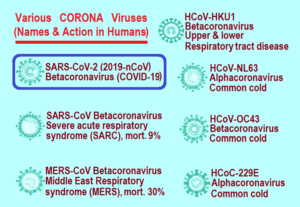Intro to Covid-19
A Lovely Monday Morning to you all!
PLEASE STAY SAFE FROM CORONA VIRUS (COVID-19). FOLLOW GOOD HAND HYGIENE and MAINTAIN SOCIAL DISTANCING
Do you know……In the wake of recent global development and the fatal impact of Corona Virus (COVID-19) pandemic, I thought of looking up for the simple description of Corona Virus and found this:

Coronavirus Image
Coronavirus disease 2019 (COVID-19) is caused by a new coronavirus first identified in Wuhan, China, in December 2019. Because it is a new virus, scientists around the world are working tirelessly to learn, find, and develop treatments for COVID-19. Coronaviruses are so named because they possess spiked surface proteins, which give the virus surface a crown/corona appearance. Coronaviruses are enveloped viruses (so is Influenza virus), which means they are covered by a membrane of cellular matter taken from their host cell and have single stranded RNA. Bats are common reservoirs of coronaviruses and mostly pass through an intermediate carrier species before infecting humans. On February 11, 2020, the World Health Organization (WHO) announced an official name for this disease, coronavirus disease 2019 (COVID-19), where ‘CO’ stands for ‘corona,’ ‘VI’ for ‘virus,’ and ‘D’ for disease. Formerly, this disease was referred to as “2019 novel coronavirus” or “2019-nCoV.”
Researchers found there are seven known coronaviruses that infect humans. Of which four are  responsible for about 15% of common colds that affect the upper respiratory tract and cause symptoms like, sore throat or runny nose. The other three coronaviruses have caused major human disease: SARS-CoV, MERS-CoV, and SARS-CoV-2 virus or “the novel coronavirus” as it’s commonly called. These three affect the lower respiratory tract, the lungs, unclear about affecting the upper respiratory tract. SARS-CoV and MERS-CoV were the cause of two major outbreaks in the last two decades in South East Asia and the Middle East. (SARS stands for Severe Acute Respiratory Syndrome, while MERS is Middle Eastern Respiratory System). SARS-CoV-2 virus is a beta coronavirus, like MERS-CoV and SARS-CoV. SARS-CoV was first identified in the Guangdong province of China in 2002, and it spread to more than 30 countries. In the 2002/2003 outbreak, SARS-CoV had about a 10% fatality rate. The intermediate source was civet cats sold in a live meat market, which had been infected by horseshoe bats acting as SARS-CoV reservoirs. SARS-CoV (the 2002/2003 virus) was successfully contained through adequate personal protective equipment for health workers, screening for abnormalities in white blood cell count, and performing chest images. Dr. A. Vaishampayan, an eminent scientist, and a noted scholar, of the prestigious university of India, Banaras Hindu University, compiled this figure from different scientific journals for public information. With his permission, I am sharing this diagram with you.
responsible for about 15% of common colds that affect the upper respiratory tract and cause symptoms like, sore throat or runny nose. The other three coronaviruses have caused major human disease: SARS-CoV, MERS-CoV, and SARS-CoV-2 virus or “the novel coronavirus” as it’s commonly called. These three affect the lower respiratory tract, the lungs, unclear about affecting the upper respiratory tract. SARS-CoV and MERS-CoV were the cause of two major outbreaks in the last two decades in South East Asia and the Middle East. (SARS stands for Severe Acute Respiratory Syndrome, while MERS is Middle Eastern Respiratory System). SARS-CoV-2 virus is a beta coronavirus, like MERS-CoV and SARS-CoV. SARS-CoV was first identified in the Guangdong province of China in 2002, and it spread to more than 30 countries. In the 2002/2003 outbreak, SARS-CoV had about a 10% fatality rate. The intermediate source was civet cats sold in a live meat market, which had been infected by horseshoe bats acting as SARS-CoV reservoirs. SARS-CoV (the 2002/2003 virus) was successfully contained through adequate personal protective equipment for health workers, screening for abnormalities in white blood cell count, and performing chest images. Dr. A. Vaishampayan, an eminent scientist, and a noted scholar, of the prestigious university of India, Banaras Hindu University, compiled this figure from different scientific journals for public information. With his permission, I am sharing this diagram with you.
COVID-19 cases were infected initially via contact with a wet market in Wuhan, China, in November and December 2019, and However, the exact source of this virus has not been identified. COVID-19 fatality rate is impossible to accurately determine as the focus currently is on very ill patients not people who are infected with mild symptoms but are not tested. Although, most people with COVID-19 have mild symptoms include fever, cough, and difficulty breathing, while some could be asymptomatic carrier of this disease. More severe cases can have lymphopenia (abnormally low level of lymphocytes in the blood) and chest imaging that looks like pneumonia. In critical cases, patients may progress rapidly to acute respiratory distress syndrome (ARDS), septic shock, metabolic acidosis, coagulation dysfunction, and even death. Some groups, including older adults and people with certain underlying health conditions (like heart disease or respiratory disease, etc.), are at increased risk of severe illness. Studies show, once the virus infects the respiratory system, the SARS-CoV-2 spike proteins bind host cell ACE2 receptors, just like SARS-CoV, that enters the host cell inside an endosome, much like influenza. People are more likely to experience severe symptoms and have a higher risk of being fatal.
Testing: Rapid antigen tests (sometimes known as a rapid diagnostic test – RDT) detect viral proteins (antigens). Samples are collected from the nose and/or throat with a swab. These tests are cheaper than PCR (polymerase chain reaction or molecular photocopying) and will offer results more quickly, although they are generally less accurate. These tests perform best when there is more virus circulating in the community and when sampled from an individual during the time they are most infectious. Both isolation and quarantine are methods of preventing the spread of COVID-19 together with using mask and maintaining adequate social distance.
Quarantine means that anyone who was in contact of someone infected with the SARS-CoV-2 virus, which causes COVID-19, whether the infected person has symptoms or not, remain separated from others in a designated facility or at home. For COVID-19, this means staying in the facility or at home for 14 days.
Isolation means being separated from other people, ideally in a medical facility where you can receive clinical care, or if you are not in a high-risk group of developing severe disease, isolation can take place at home. If you have symptoms, you should remain in isolation for at least 10 days plus an additional 3 days without symptoms. If you are infected and do not develop symptoms, you should remain in isolation for 10 days from the time you test positive.
For now, the good news is that the United States has two Covid-19 vaccines that have been shown to be highly effective at preventing symptomatic Covid-19 infection, measured starting from seven days after the second dose was administered.
Om Healing………..Uma
(Founder of AromaWellness)
to order .visit aromawellness.net
Call 414-793-8645, to schedule your consultation appointment
combined with Reiki & Chakra Healing





Recent Comments